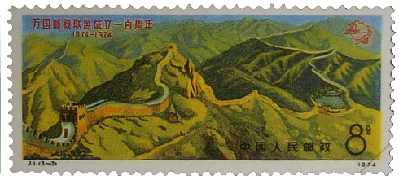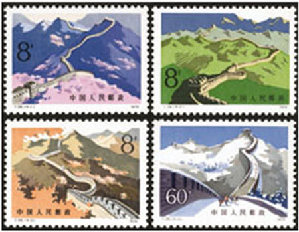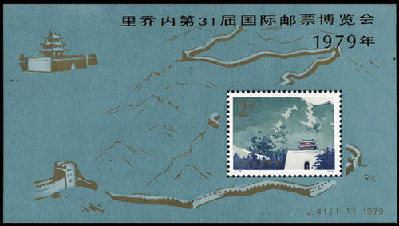World cultural heritages on stamps
Though it seems to be two irrelevant items, stamps and the world cultural heritage are both the carriers of human culture and spirit. The issues of world cultural heritage stamps are a combination demonstrating the magnificence of human wisdom and power. Travelers to China have been told tales of magic landscapes and exotic cultures. Chinese civilization is the oldest in the world and is today’s the largest civilization. As its culture center, Beijing is home to a wide range of historical heritages. The Great Wall, the Temple of Heaven, the Summer Palace and three other World Heritage Sites in Beijing have issued it stamps.
The Great Wall
The Great Wall of China is a series of stone and strong earthen foundations in northern China, built originally to protect the northern borders of the Chinese Empire against intrusions by various nomadic groups such as the Hun from the north. The wall has been rebuilt and maintained between the 5th century BC and the 16th century. Since the 5th century BC, several walls have been built that were referred to as the Great Wall. One of the most famous is the wall built between 220–206 BC by the first Emperor of China, Qin Shi Huang. Little of that wall remains; the majority of the existing wall was built during the Ming Dynasty. Till now, the Great Wall has a history of 450 years.
|
 The one is issued on May 15th, 1974. It showscases the magnificent Great Wall. |
The Great Wall stretches from Shanhaiguan in the east to Lop Nur in the west, along an arc that roughly delineates the southern edge of Inner Mongolia. The most comprehensive archaeological survey, using advanced technologies, has recently concluded that the entire Great Wall, with all of its branches, stretches for 8,851.8 km.
|
 The one is issued on June 25th, 1979. It illustrates the beauty of the Great Wall during various seasons.
|
The Chinese were already familiar with the techniques of wall-building by the Spring and Autumn Period. During the Warring States Period (5th century BC-221 BC), the states of Qi, Yan and Zhao all constructed extensive fortifications to defend their own borders. Built to withstand the attack of small armies such as swords and spears, these walls were made mostly by stamping earth and gravel between board frames. Qin Shi Huang conquered all opposing states and unified China in 221 BC, establishing the Qin Dynasty. Intended to impose centralized rule and prevent the resurgence of feudal lords, he ordered the destruction of the wall sections that divided his empire along the former state borders. Unlike the earlier Qin fortifications, the Ming construction was stronger and more elaborate due to the use of bricks and stone instead of rammed earth. As Mongol raids continued periodically over the years, the Ming devoted considerable resources to repair and reinforce the walls. Sections near the Ming capital of Beijing were especially strong. Many countries have issued suits stamps of the Great Wall, among which China issued near 200 stamps. The first one was issued during the years of 1894 and 1895.



















